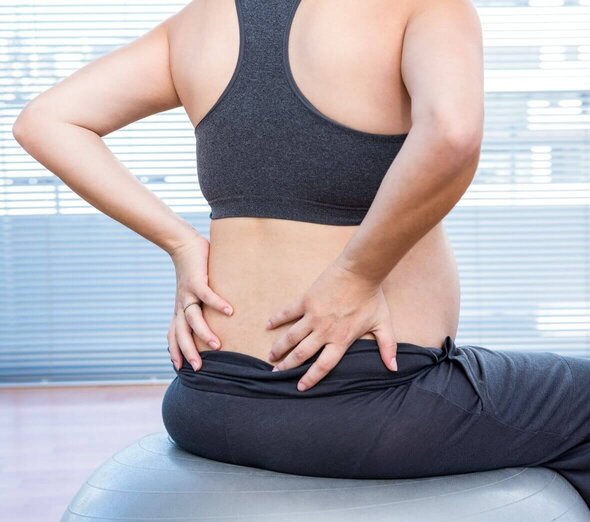

It is very important that you find your most comfortable position during labour. This is very helpful for you and your baby. When you choose the correct position for yourself, your child may quicker appear on the world and the childbirth will be much smoother. It is enough if you properly respond to the movements of your baby trying to get out through the birth canal.
In the first stage of the labour you can stand, crouch, kneel, walk and sit. The baby moves down the birth canal with uterine contractions. Thanks to the gravitational force his head pushes the cervix more and more and its dilation progresses faster. Therefore it is so important to move in the first stage of the labor.
Use all available help: a ball, a ladder, a low stool, a sill or a mattress, not to mention the assistance of your partner. Try different positions until you find the most comfortable one, in which the child will most easily pass through the birth canal.
In some hospitals you can take a relaxing bath that relaxes muscles, reduces the strength of contractions and accelerates cervical dilation.
During the first stage of the labour, you will certainly feel the fear and anxiety. You can then walk around the room or the corridor. If you find it difficult to walk, you can ask for help someone close to you, or lean back on the bed.
Movement and standing position help to extend the pelvis, so the child can position himself comfortably to come into the world.
Standing position with a partner
In this position you stand with your legs apart. You lean against the arms of an accompanying person and bend slightly forward so that your belly can freely hang down. When you feel the contraction, shake your hips. You partner can make similar movements. Slight bend forward will release your spine.
The accompanying person can stand behind you and hold you under your armpits. You stand astride and keep your hands on your belly.
This position may be uncomfortable for the midwife, who will have to deliver the baby sitting on the floor. Besides, your control over labour is limited and you can also feel strong leg pain. For these reasons, when you use this position some help from the accompanying person is necessary.
Sitting on a ball
This position is good for the onset of the labour when the baby's head is still high. You sit on a ball with legs apart, feet standing on the floor. You can put your hands on your knees or hold on something to catch your balance. Turn your hips rhythmically in both directions.
While sitting on the ball, you can also gently jump on it. Such movements relax the pelvic floor, helping you to breathe freely.
Leaning forward on your knees
If you feel that the contractions do not intensify, you can benefit from a kneeling position and leaning forward, that affects the strength and regularity of contractions. Keeping your legs astride helps the baby's head to position in the birth canal.
Kneel on one knee, putting a blanket or a pillow under it. Put the other foot flat on the floor. Move your body weight to it by rhythmical movements. Try to do this exercise during a contraction, simultaneously stretching the groins. Do not forget about breathing. Breathe in while you lean forward and breathe out while coming back. This exercise should be repeated several times on one knee.
Sitting on your heels
Kneel down and sit comfortably on your heels, spreading your knees widely. Straighten your arms and put your hands on the floor or on the thighs with fingers in the inside direction.
This position is suitable when your contractions are strong and the first stage of the labour is well advanced. Leaning forward, you cause the baby's head move quickly through the birth canal. Remember to breathe. To improve the effect and reduce the pain during contractions you can sway back and forth.
Lying position
Position yourself comfortably on your left side. Put a pillow under your head and right knee. If you are more comfortable on the right side, you can also choose this option, but keep in mind that when you are lying on the left side, the blood supply to the baby is much better.
In the lying position intensity of the contractions weakens. You can use this time for a short relax. Especially during a long labour a woman needs rest to gather strength before the next contraction.
Kneeling position with a ball
Try this position if you feel pain in the lower back. Stand widely astride on all fours or sit on your heels, leaning your arms and head on the ball. When you have a contraction, roll back and forth on the ball. In this position you gently press your belly, causing stronger contractions. This allows the child to move more and more downwards.
During the second stage of labor - the transition phase - you should be active. Use the help of an accompanying person or wall bars. Pushing in different positions helps to accelerate the labour.
Kneeling push
In this position you will need help of an accompanying person. It is recommended to women giving birth to bigger babies. It facilitates dilatation and reduces pressure of the baby's head on the perineum, as well as diminishes the risk of skin tearing.
Kneel on a mattress or a blanket with your legs wide apart. Place your hands and neck on your partner's arms.
Squatting push
Crouch flat on your feet. Your legs must be wide apart. The accompanying person should sit on a high chair, so that your buttocks do not touch the floor. During the contraction you lean against your partner's legs and he put can put his hands under your armpits.
In this position it very often happens that a child moves without you pushing, just as a result of contractions.
Squatting push at the wall bars
You crouch down on the flat-based feet with legs slightly apart. To maintain balance you hold one of the bars with outstretched arms. You can also hold on to a bed frame or a window sill. Stay in this position during contraction. Remember that you should stand up after the contraction to stretch your legs.
This position makes it much easier for the baby to move in the birth canal towards the exit.
Side pushing
Lie on a bed with your legs bent at the knees, on the right or left side (choose the one more convenient for you). Sometimes a midwife will recommend a specific side, it depends on the baby's position in the womb. Place pillows under your head and trunk, or you can ask for lifting the top part of the bed. During the contraction, try to curl up, pull your leg toward yourself and try to bend your head inward. This position provides more pressure on the diaphragm, resulting in stronger effect of pushing.
Pushing in a half-sitting position
Sit on the maternity bed and widely spread knee-bent legs. During the contraction the accompanying person bends your head while you grab the bed railing and try with all your strength to pull it to yourself or lift on the elbows. You can also try to lean both feet against the bed or hold your knees with both hands pulling the legs towards yourself.
This is a particularly convenient position for a midwife, who can then easily monitor the situation. However, it can be painful for you, because it is difficult to bend the coccyx.
During the break between contractions you can ask your partner or a midwife to massage the most painful and tight places such as your shoulders, lower back, face and legs.
If it does not bring you relief but is only irritating, your partner can just put his hands on the painful spots. This touch will also make you feel better. If you do not want anyone to touch you, say it, as you have right to feel like that.
The midwife will certainly advise you what position to choose and what would be the most comfortable. Your attitude and willingness to cooperate is very important. You can do it, because women have enormous dormant potential, which we even do not realize and which allows us to survive the pains of childbearing. Remember! Do not worry, be brave, and everything will be fine.